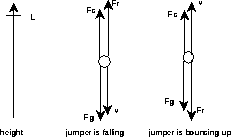Until the jumper is L feet below the bridge, where L is the length of the cord, the bungee cord exerts no force on the jumper.
The only forces we need to consider before the jumper is L feet below the bridge are the force of gravity and air resistance.
According to Newton's law, the force of gravity is

where

The force of gravity is equal to the jumper's weight, which for this project we will assume is 160 pounds. In other words, his mass is 5 slugs. This means the force of gravity is constantly 160 pounds (s. ft./.sec.2) acting in the downward direction.
The force of air resistance (Fr), on the other hand, is always changing with velocity.
The force of air resistance is opposite to velocity (just as in the air resistance project), but proportional to the
 power, because the diver goes head down with his arms tucked in for maximum thrill.
power, because the diver goes head down with his arms tucked in for maximum thrill.

where

The proportionality constant in this case is 0.1.





 ? Give your answer in ft/sec and mph.
? Give your answer in ft/sec and mph.


 , for natural length L.
, for natural length L.



